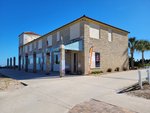

After efforts spanning two decades, a beachfront hotel has been listed on the National Register of Historic Places.
The St. Johns Cultural Council has worked for more than 20 years to restore and preserve the historic St. Augustine Beach Hotel, which has now been recognized by the U.S. National Park Service for the property’s national civil rights significance and local historical, architectural importance.
According to Christina Parrish Stone, St. Johns Cultural Council’s executive director, the Cultural Council helped to save the structure from demolition and raised hundreds of thousands of dollars in grants and private donations to stabilize the building and restore the first floor, which now houses dance and art studios.
The council is currently working with the City of St. Augustine Beach to develop plans to complete the second floor, and a workshop to receive input from the community will be held in March.
On Jan. 14, the National Park Service released information that the St. Augustine Beach Hotel and Beachfront in the City of St. Augustine Beach has been added to the National Register of Historic Places for importance nationwide as part of the civil rights movement known as the St. Augustine Campaign. The hotel is located at 370 State Road A1A.
To establish the significance of the historic property and prepare the National Register nomination, the St. Johns Cultural Council engaged consultant Leslee Keys Ph.D. and Keys and Associates of St. Augustine.
According to Keys, the Rev. Dr. Martin Luther King Jr. selected St. Augustine as the third of a trilogy of Southern cities for staged protests designed to generate attention when the U.S. Senate was debating and filibustering the much-delayed Civil Rights Act of 1964.
The St. Augustine Beach Hotel property and the beachfront from 16th Street northward to the hotel were the settings for multi-cultural wade-ins, which activists conducted continuously from June 17 until July 1, 1964, the day before President Lyndon B. Johnson signed the Civil Rights Act of 1964 into law.
The wade-in that occurred at the beach on June 25, 1964, is best known for segregationists attacking protestors along the beach. Images of the Florida Highway Patrol breaking up the riot and standing fully uniformed in the ocean to protect the protestors were among the most circulated of the entire St. Augustine movement.
The historical and architectural significance of the building includes its design by local architect Francis A. Hollingsworth as a wood building with coquina block veneer, and additional period materials to support commercial use.
The hotel, which opened on Labor Day in 1940, is the only building remaining from a “St. Augustine Auxiliary Pier Project” by the federal Works Progress Administration (WPA) during the Great Depression. The Anastasia Island coquina quarry location was reopened for construction of WPA buildings, specifically the twin beach hotels.
“Historic sites and historic preservation are critically important to our community and to cultural tourism in St. Johns County,” said Parrish Stone. “Raising awareness of these sites through recognition such as this and increasing access to funding for historic preservation are key components of our efforts to support, promote and enhance the arts, culture and heritage of the area. St. Johns Cultural Council and its supporters are thrilled by this recognition for a property that has been an important part of the work to sustain our vibrant cultural community.”
The mission of the Cultural Council is to support local artists and arts organizations and to promote St. Johns County as a premiere destination for cultural travelers, ensuring that the lives of both residents and visitors are enriched through art, culture, history, and heritage.
For more information, contact Parrish Stone at 904-434-0959 or email christina@historiccoastculture.com. The website is stjohnsculture.com.